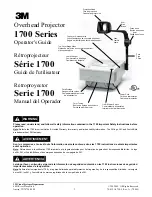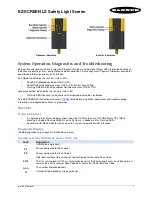
1-2
D4K25 Service Manual
020-100880-01 Rev. 1 (06-2012)
Section 1: Introduction
1.2.1 Control
External control signals, whether local or remote, are physically routed to the source and communication panel
on the operator’s side of the projector.
1.2.2 Touch Panel Controller (TPC)
The TPC is the local user interface, and provides a complete Windows XPe-based graphical user interface. It
provides an easy-to-use, intuitive, local user-interface for operation and status monitoring of the projector
while viewing the screen through the port window. The TPC mounts on the rear of the projector and can be
adjusted to virtually any angle using the included double ball joint mount to allow convenient viewing and
flexible operation in various installation configurations.
1.2.3 PC/Laptops or Servers
Almost all TPC projector functions can be initiated remotely from a controller in the form of simple bi-
directional ASCII messaging. Whether from a stand-alone computer, server, or an existing Ethernet network,
the equipment connects to the projector via an Ethernet link. RS232 cannot be used for ASCII messaging to
and from the TPC (which requires Ethernet), and it is too slow for server use. In installations where the server
is also the controller, the projector may take its cues directly from the source material and/or the server-
controller via an Ethernet link only. For complete details on controlling the projector via ASCII messaging
instead of using the TPC screen, see
.
1.2.4 Projector Intelligence Board (PIB3G)
The PIB3G is the main controller and primary video interface card in the cardcage. Its main function is to
control the video path, monitor the environmental circuits and devices inside the projector, connect with
communication interfaces and provide Dual 3G-SDI and Twin DVI video input ports. The PIB3G is also
responsible for the 37-pin GPIO, SCCI and RS232 type interfaces. Located on the PIB3G faceplate are a
number of LEDs and buttons used for basic status and control.
1.2.5 Lamp Power Supply Interface Signals
Two communication/control cables link the digital lamp power supply (LPS) to the rest of the projector. One
cable carries RS232 (serial) signals for adjusting the LPS' output power and monitoring its operation, and the
other carries a "lamp enable" signal and four interlock signals. Three of the interlock signals originate in the
head (for the lamp door, lamp fan, and exhaust duct). The fourth interlock can be connected, if required, to the
venue’s fire alarm system - this would then shut the lamp OFF in the event of a fire, and is a safety requirement
in certain countries. For sites in which the fourth interlock is not used, it is jumpered closed. The LPS
communication/control cables each route to their own 9-pin connector located on the operator's side of the
LPS.
Содержание D4K25
Страница 1: ...D4K25 S e r v i c e M a n u a l 020 100880 01...
Страница 2: ......
Страница 3: ...D4K25 S e r v i c e M a n u a l 020 100880 01...
Страница 10: ......
Страница 18: ......
Страница 30: ......
Страница 52: ......
Страница 92: ......
Страница 93: ...Section 6 Interconnections D4K25 Service Manual 6 3 020 100880 01 Rev 1 06 2012 6 1 D4K25 Interconnect Drawing...
Страница 94: ......
Страница 132: ......
Страница 135: ...Appendix A Exploded Views D4K25 Service Manual A 3 020 100880 01 Rev 1 06 2012 A 1 Exploded View Internal...
Страница 136: ...Appendix A Exploded Views A 4 D4K25 Service Manual 020 100880 01 Rev 1 06 2012 A 2 Exploded View External...
Страница 137: ......













































